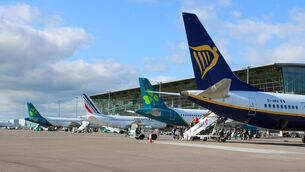Low-cost airlines ‘seek to shed no-frills image’

In its latest accounts, Emirates reported profits of €5.5bn from just under 50 million passengers. Ryanair’s profits for the same period rose 66% to €614m from 80 million passengers.
In its 30-year history, Emirates has doubled in size every three to four years. Ryanair and some other successful low-cost carriers have had comparable growth. However, air travel trends are changing rapidly, both for passengers and the airlines.
“I am not so sure that level of growth is sustainable,” Mr Corneille told a seminar in Cork for the Munster branch of the Sales Institute.
“We are getting to a point now where the existing business model is not so scalable. This is why the lines are beginning to blur between low-cost and full-service carriers. Low-cost carriers have had a clear run for the past 15 to 20 years, but now they need higher margins to sustain their growth. So they are looking at business-class passengers.
“In a word, they want more suits. So Easyjet cabin crew are no longer wearing orange jumpsuits; they now wear charcoal grey suits. Ryanair are also changing their attitude to try to appeal to more business passengers,” he said.
Mr Corneille said Emirates has differentiated itself in a very competitive and relatively homogenous industry.
The airline’s success is intrinsically linked to the evolution of Dubai itself, where Sheikh Ahmed bin Saeed Maktoum ignored the advice of consultants in the mid-1980s to turn a relatively innocuous desert city into what is now the busiest hub in global aviation.
Mr Corneille likens Emirates to Ryanair. While offering very different products, both have largely been led by one visionary right from the outset.
“During my time with Aer Lingus, I worked with 14 CEOs,” said Mr Corneille.
“If you keep changing leader, you’ll always have difficulty with your vision and your strategy. Emirates and Ryanair have had just one chief executive for most of the past 30 years. So it is no surprise those are the two most successful airlines in the world,” he said.
He said airlines need a strategic approach covering customer service ethos, choice of airports, routes, fuel costs, passenger and cargo balance, culture and brand. While most airlines are heavily dependent on one continent, no single zone accounts for more than 30% of income for Emirates.
He said a sharp focus is critical in an industry with such tight margins. While retailers typically operate on a 50% profit margin on full-priced goods, profits account for just 1.8% of the total price of an airline ticket.
“In an industry working on a margin of less than 2%, it doesn’t take much to knock you off track,” Mr Corneille said.















